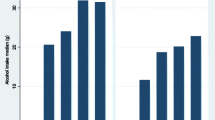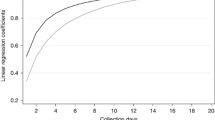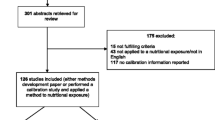Abstract
The issue of estimating usual nutrient intake distributions and prevalence of inadequate nutrient intakes is of interest in nutrition studies. Box–Cox transformations coupled with the normal distribution are usually employed for modeling nutrient intake data. When the data present highly asymmetric distribution or include outliers, this approach may lead to implausible estimates. Additionally, it does not allow interpretation of the parameters in terms of characteristics of the original data and requires back transformation of the transformed data to the original scale. This paper proposes an alternative approach for estimating usual nutrient intake distributions and prevalence of inadequate nutrient intakes through a Box–Cox t model with random intercept. The proposed model is flexible enough for modeling highly asymmetric data even when outliers are present. Unlike the usual approach, the proposed model does not require a transformation of the data. A simulation study suggests that the Box–Cox t model with random intercept estimates the usual intake distribution satisfactorily, and that it should be preferable to the usual approach particularly in cases of highly asymmetric heavy-tailed data. In applications to data sets on intake of 19 micronutrients, the Box–Cox t models provided better fit than its competitors in most of the cases.



Similar content being viewed by others
References
Block G (1982) A review of validations of dietary assessment methods. Am J Epidemiol 115:492–505
Borrelli R, Simonetti MS, Fidanza F (1992) Inter and intra individual variability in food intake of elderly people in Perugia (Italy). Br J Nutr 68:3–10
Box GEP, Cox DR (1964) An analysis of transformations. J R Stat Soc Ser B 26:211–252
Carriquiry AL (1998) Assessing the prevalence of nutrient inadequacy. Public Health Nutr 2:23–33
Cole TJ, Green PJ (1992) Smoothing reference centile curves: the LMS method and penalized likelihood. Stat Med 10:1305–1319
Dodd KW, Guenther PM, Freedman LS, Subar AF, Kipnis V, Midthune D, Tooze JA, Smith SMK (2006) Statistical methods for estimating usual intake of nutrients and foods: a review of the theory. J Am Diet Assoc 106:1640–1650
Ferrari SLP, Fumes G (2017) Box–Cox symmetric distributions and applications to nutritional data. Adv. Stat Anal 101:321–344
Hubert M, Vandervieren E (2008) An adjusted boxplot for skewed distributions. Comput Stat Data Anal 52:5186–5201
Institute of Medicine, Food and Nutrition Board (2003) Dietary reference intakes: applications in dietary planning. National Academies Press, Washington. [Acessed in 31 May, 2017], Subcommittee on interpretation and uses of dietary reference intakes and the standing committee on the scientific evaluation of dietary reference intakes. Available at https://www.ncbi.nlm.nih.gov/books/NBK221369/pdf/Bookshelf_NBK221369.pdf
Nutrition Coordenating Center (2012) Nutrition data system for research. NDS-R. Features. http://www.ncc.umn.edu/products/. Accessed 31 May 2017
Pinheiro JC, Bates DM (1995) Approximations to the log-likelihood function in the nonlinear mixed-effects model. J Comput Graph Stat 4:12–35
R Core Team (2008) R: a language and environment for statistical computing. R Foundation for Statistical Computing, Vienna, Austria. ISBN: 3-900051-07-0
Rigby RA, Stasinopoulos DM (2006) Using the Box–Cox t distribution in GAMLSS to model skewness and kurtosis. Stat Model 6:209–229
SAS Institute Inc. (2012) SAS/STAT 12.1 user’s guide. SAS Institute Inc., Cary
Slater B, Marchioni DL, Fisberg RM (2004) Estimating prevalence of inadequate nutrient intake. Rev. Saúde Pública 38:599–605
Souverein OW, Dekkers AL, Geelen A, Haubrock J, Vries JH, Ocke MC, Harttig U, Boeing H, Veer P (2011) Comparing four methods to estimate usual intake distribution. Eur J Clin Nut 65:S92–S101
Stasinopoulos DM, Rigby RA (2007) Generalized additive models for location, scale and shape (GAMLSS) in R. J Stat Softw 23:1–46
Tooze JA, Kipnis V, Buckman DW, Carroll RJ, Freedman LS, Guenther PM, Krebs-Smith SM, Subar AF, Dodd KW (2010) A mixed-effects model approach for estimating the distribution of usual intake of nutrients: the NCI method. Stat Med 29:2857–2868
Voudouris V, Gilchrist R, Rigby RA, Sedgwick J, Stasinopoulos DM (2012) Modelling skewness and kurtosis with BCPE density in GAMLSS. J Appl Stat 39:1279–1293
Acknowledgements
We thank the reviewers for their valuable comments and suggestions on an earlier version of the paper. We gratefully acknowledge the financial support of the Brazilian agencies FAPESP (grants 2008/10261-8 and 2012/21788-2) and CNPq (grant 304388/20149).
Author information
Authors and Affiliations
Corresponding author
Rights and permissions
About this article
Cite this article
Fumes-Ghantous, G., Ferrari, S.L.P. & Corrente, J.E. Box–Cox t random intercept model for estimating usual nutrient intake distributions. Stat Methods Appl 27, 715–734 (2018). https://doi.org/10.1007/s10260-018-00438-6
Accepted:
Published:
Issue Date:
DOI: https://doi.org/10.1007/s10260-018-00438-6




